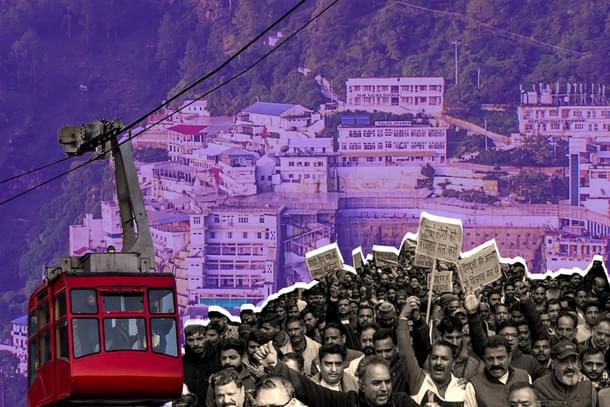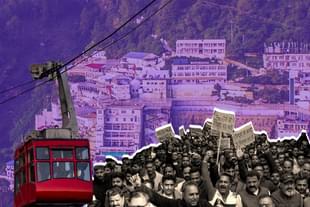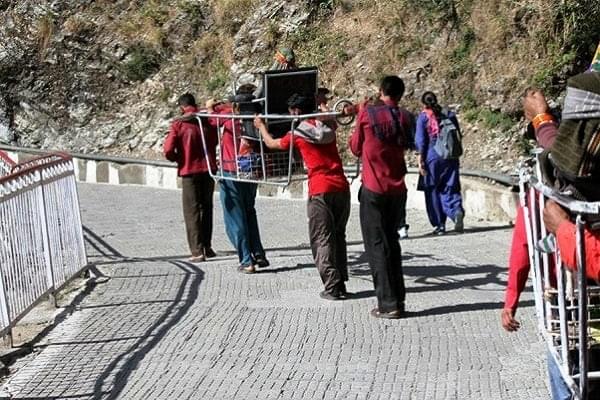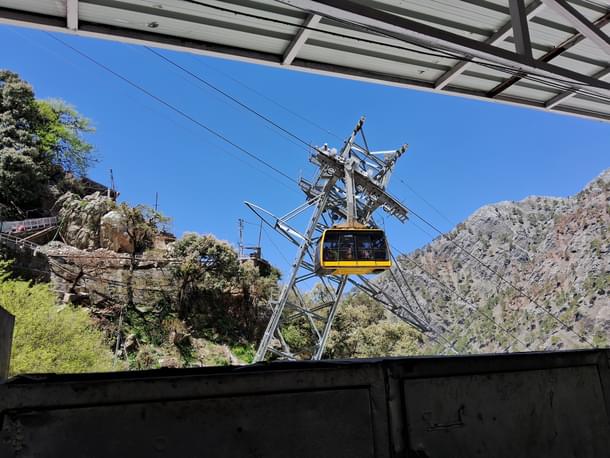Infrastructure
Ropeway Project At Vaishno Devi: Why Supporting Such Infrastructure Initiatives Is Crucial For Improving Pilgrims' Experiences
Swarajya Staff
Dec 20, 2024, 04:20 PM | Updated 04:20 PM IST
Save & read from anywhere!
Bookmark stories for easy access on any device or the Swarajya app.


The sacred pilgrimage to Shri Mata Vaishno Devi Bhawan in Jammu, a journey undertaken by millions each year, is facing a controversy as locals protest against the proposed ropeway project aimed at enhancing access to the shrine.
The project, designed to connect Katra town directly to the Bhawan, has led to widespread opposition from shopkeepers, pony service providers, porters, who fear it will disrupt their livelihoods.
Katra town has acted as the base and gateway for pilgrims embarking on their nearly 13-km trek to the Shri Mata Vaishno Devi temple.
However, on 18 December, the town observed a bandh, with protestors voicing their opposition.
As per reports, representatives of the shopkeepers' association, stated, “We will not allow the ropeway project to be implemented in Katra. We have been fighting against it for three years. Assurances were given to us in the past, but now they have gone ahead with the project.”
The Shri Mata Vaishno Devi Shrine Board announced plans to construct the Rs 300-crore ropeway, which will reduce the travel time required for the pilgrimage. This will especially benefit senior citizens, children, and those unable to make the arduous climb.
Currently, the trek takes 6–7 hours on foot, while the ropeway is expected to cut this to just six minutes, covering more than 90 per cent of the way.
Infrastructure for religious tourism
As India’s religious tourism continues to grow, infrastructure projects like this are seen as essential to accommodate the rising number of pilgrims.
The shrine board also emphasised on the importance of the project, calling it a crucial upgrade for increased accessibility to the Bhawan.
Despite these advantages, locals argue that the project’s direct route will bypass key stops along the traditional pilgrimage path, depriving businesses of essential foot traffic.
The Journey To The Bhawan
For years, the only way to reach the shrine located at 5,200 feet had been the steep trek along the Katra-Adhkuwari-Bhawan route.
Over time, several alternatives have been added, such as pony rides, palanquins, and porters who assist by carrying the people, luggage or even infants in prams.
Walking all the way can be exhausting, especially for the elderly, and those unaccustomed to such physical exertion, as the altitude also adds to the challenge.
Further facilities were added to improve accessibility such as helicopter services and electric battery cars, which now operate on newly developed routes, providing another option for those unable to trek.
However, the demand for these services remains overwhelming throughout. It mostly require bookings two months in advance, and also remains unaffordable for many pilgrims.
Thus, traditional modes such as ponies, palanquins, and porters, continue to play a role in supporting pilgrims.
Even with these alternatives, the increasing number of devotees has stretched existing resources to their limits, which means that the journey remains a challenge for many.

The Growing Numbers
Over 95 lakh pilgrims visited the holy site in 2023.
The rise in pilgrim numbers continues each year, with increasing awareness of the site as well as improved connectivity to Katra.
Previously, pilgrims had to travel to Jammu Tawi, the nearest major railway station, followed by a 2–3-hour road journey to reach Katra.
However, the extension of railway connectivity directly to Katra in recent years has increased visitor numbers.
The annual footfall in 2000 was approximately 52 lakh, and over the past two decades, this figure has nearly doubled.
Further, time periods such as the days of Navratri, see a sharp surge in demand, sometimes exceeding the capacity of available infrastructure.
This year, by November, nearly 90 lakh pilgrims have already been registered.
But for many still, the journey remains inaccessible. Helicopter services can accommodate only 5–6 passengers per trip, while the number of electric battery cars is similarly constrained.
The sheer volume of pilgrims leaves many without suitable ways to reach, which points at the need for expanded and inclusive solutions to meet the demands of this growing pilgrimage.
Challenges For Devotees
With such issues, devotees visiting the Vaishno Devi shrine, as well as the workers there, often rely on informal arrangements to make their way.
While services like ponies and porters are regulated with fixed rates set by the shrine board, exploiting the desperation of devotees remains a common practice, with demands of additional charges.
Similarly, many can be seen making informal arrangements with goods vehicles traveling to the shrine.
Some pilgrims hide among goods or sit atop these mountain-bound vehicles, posing risks to themselves as well as others on the route. At the same time, drivers also demand unreasonable sums, reportedly up to Rs. 3,000 per person.
Many adults can also be seen squeezing into children's prams while going downhill, as they are left with no other choice.
Infrastructure Expansion Remains Essential
Scenarios like these highlight the need for a mass transit solution, capable of reducing challenges as well as enhancing the overall pilgrimage experience.
The proposed 2.4-kilometer ropeway from Tarakote, near the Katra base camp, to Sanjichhat is a critical step in this direction.
Once operational, it will be capable of transporting 1,000 passengers per hour, reducing travel time and making the journey more accessible to devotees.
It is also equally important for the local community in Katra to recognise the benefits of such infrastructural advancements, as it would attract more tourists to the town and shrine.
Presently, beyond the Bhawan, pilgrims extend the journey to the Bhairon temple, requiring another trek.
For the same, a ropeway is already operational and charges a nominal fare of Rs. 100, reducing the travel time from three hours to just five minutes.

As this facility has proven success, it presents the potential of such projects for improving the overall pilgrimage experience.
Many pilgrims in Katra also support the new ropeway project, as they believe that these are required for the collective benefit of pilgrims.
Devotees who prefer trekking will still have the option to do so, preserving existing route and journey.
They add, “The businessmen should view the project as one helping the needs of the pilgrims and the sanctity of the pilgrimage itself. After all, it is the temple and the faith of the devotees that have provided livelihoods to the local community for decades.”
Moreover, regulating the transportation will also control the local economy, preventing exploitative practices that exist today, and can set a benchmark for other religious destinations.





